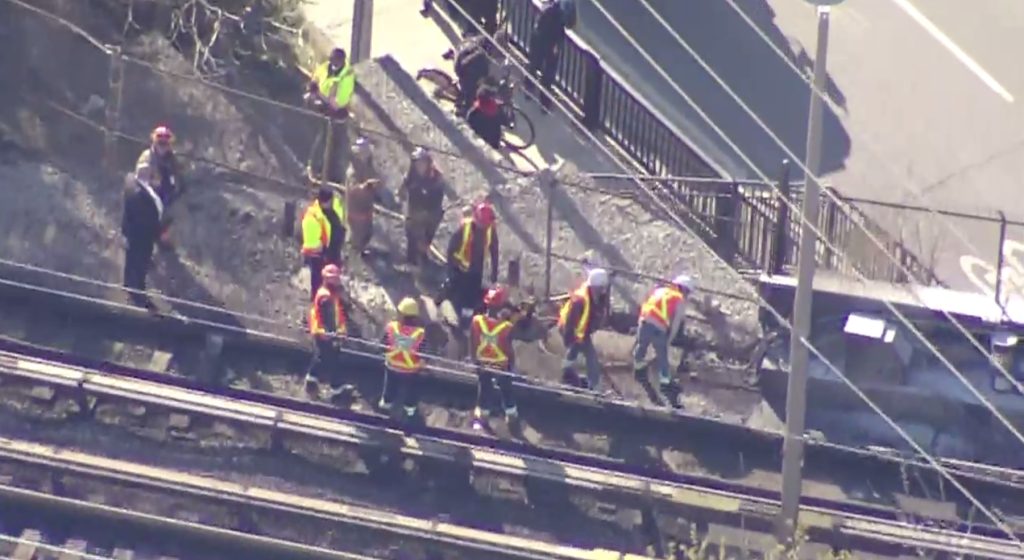FACT SHEET: The most significant storms to hit Toronto & GTA
Posted October 29, 2012 1:16 pm.
This article is more than 5 years old.
The remnants of Hurricane Sandy and a cold front are expected to merge to create a wet, cold, blustery and potentially severe storm that’s expected to hit the GTA on Monday night.
Toronto has experience dealing with major storms and their aftermath — most notably Hurricane Hazel nearly six decades ago. Here’s a look back at some of the weather events that have shaped the history of the GTA and other communities and their response to serious weather events.
Oct. 15, 1954 – Hurricane Hazel:
The infamous storm that devastated Toronto, particularly neighbourhoods along the Humber River, hit the evening of Oct. 15, 1954 – and subsequently changed how this city prepares and copes with extreme weather.
The storm dumped 300 million tonnes of rain on Toronto, according to the City of Toronto and Environment Canada, washing out bridges, roads and tearing homes from their foundations.
Eighty-three deaths were reported in Ontario, 36 of them on Raymore Drive, near Lawrence Avenue and Scarlett Road. According to the Toronto and Region Conservation Authority (TRCA), residents weren’t aware of the severity of the storm and didn’t act accordingly.
Three years after Hazel, the TRCA was formed to manage the city’s wetlands and floodplains.
The city adopted a flood control plan in 1959 that included land expropriation and dam and reservoir construction, according to the TRCA.
Click here for more information on Hurricane Hazel.
May 31, 1985 – the Barrie tornado
An F-4 twister — one of a series of tornadoes to touch down that day — hit Barrie in the late afternoon on May 31, 1985, killing eight people. Sixty others were seriously injured in the storm.
The storm hit Barrie’s Allandale neighbourhood particularly hard and ripped through the Barrie racetrack.
Aug. 21, 2011 – Goderich tornado
An F-3 twister ripped through Goderich, dubbed the prettiest town in the country, on Aug. 21, 2011 — the most powerful storm recorded in the province since 1996. Nearly 40 people were injured and salt mine worker Normand Laberge, 61, was killed.
The twister ripped through the centre of the community, damaging historic buildings, ripping the roofs off of houses and downing power lines.
A year after the storm, about 90 per cent of businesses affected by the tornado reopened.
Aug. 20, 2009 – Vaughan tornadoes
At least 18 tornadoes touched down across Ontario on Aug. 20, 2009 — at least four of them in the Maple and Woodbridge areas.
More than 600 homes were damaged in the storm, including 38 that required serious repairs.
There were unconfirmed reports of a funnel cloud near Yonge and Bloor streets at the time, according to Environment Canada. The storm also caused major flooding along the lakeshore.
Eleven-year-old Owen McPherson was killed on that day. He was at a day camp at a conservation site in Grey County when a tornado hit there.
January 1999 – Snow storm – Toronto calls in the troops
The series of snowfalls in January 1999 created headaches for Torontonians and made the city the butt of jokes for others around the country when then-mayor Mel Lastman called in the army to help the city dig out.
Toronto experienced its snowiest January ever when 118.4 centimetres fell over a few weeks in 1999. The city also recorded its greatest snow on the ground at any one time with 65 centimetres, according to Environment Canada.
The first wave hit on Jan. 2 and affected a large swath of southern Ontario and four additional storms made it the snowiest two-week period in Toronto since 1846, according to city records.
Downtown streets were clogged and Lastman implemented a ban on cars parking on snow routes. The mayor asked for military assistance on Jan. 14. He said snow was making it nearly impossible for emergency vehicles to navigate downtown streets.
At least 438 soldiers arrived with 128 military vehicles from CFB Petawawa to the old Downsview base. Another 110 reservists were on standby. The army brought eight Bisons, special mini-vehicles that could traverse a narrow path and clear the snow away.
“If things are bad, I don’t want to take any chances,” Lastman said. “I will not risk the lives of people in Toronto.”
The city spent nearly twice the annual snow clearing budget in the aftermath, according to Environment Canada.
Dec. 11, 1944 – Toronto’s Biggest One-Day Snowfall
The city recorded its worst single-day snowfall on Dec. 11, 1944 when a storm dropped 48 centimetres downtown. Gale-force winds created huge drifts. A total of 57.2 centimetres fell over two days, according to Environment Canada.
Twenty-one people died during the storm, including 13 from overexertion, the federal weather agency said.
The massive snowfall forced factories producing ammunition for the Second World War to close temporarily. Funerals were also postponed, expectant moms had to be walked to hospitals and home deliveries were cancelled, according to Environment Canada.










